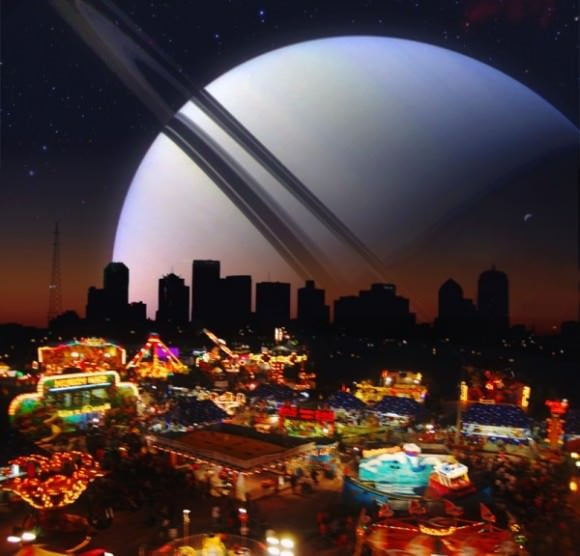Welcome, come in to the 349th Carnival of Space! The carnival is a community of space science and astronomy writers and bloggers, who submit their best work each week for your benefit. I'm Susie Murph, part of the team at Universe Today and now, on to this week's stories!
Humans have an important connection to light, and a new public science exhibit being created for the International Year of Light 2015 will explore how light is inextricably tied to us as citizens of planet Earth, as members of our Galaxy, and as part of the cosmos. Learn more about the exhibit and the International Year of Light 2015 at the article
here
on the
Astronomers Without Borders
site.
[caption id="attachment_111187" align="alignright" width="250"]
"El Gordo," Credit: NASA[/caption]
Next, we're off to the
Chandra X-ray Telescope blog
to look at one of the beautiful ways light can appear to us. This beautiful
composite image
of X-rays from Chandra and optical data from Hubble of the galaxy cluster ACT-CL J0102-4915, nicknamed "El Gordo," is the most massive, the hottest, and gives off the most X-rays of any known galaxy cluster at its distance or beyond.
Beautiful images like "El Gordo" can inspire fantastic artwork, and Jim Plaxco from the
ArtsNova blog
shares
his recent experiences
judging some of this artwork from the National Space Society's Roadmap to Space Settlement 2014 International Student Art Contest. The students had to create artwork referencing exploration, utilization and settlement of asteroids or the construction of orbital space settlements.
Speaking of beautiful artwork, Pamela Hoffman from
Everyday Spacer
enjoys the artwork in the This Year in Space 2014 calendar. Read more of her review and learn how you can still enjoy this artwork, even though the calendar is sold out,
here
.
[caption id="attachment_111185" align="alignleft" width="250"]
Skydiver almost hit by meteorite? Probably just a rock.[/caption]
Now, we can leave the confines of the ground, and look at some incredible skydiving footage that has had scientists and space fans buzzing all weekabout the possibility of a near-miss by a meteoroid. Nancy Atkinson at
Universe Today
was on top of this developing story all week, and has resolved the mystery of the Skydiver's Rock. You can read the updated story
here
.
Well, the skydiver was still within the Earth's atmosphere, but we're heading out further - to our Moon. The
Lunar and Planetary Institute
has released over 600 documents related to the development, deployment, and operation of the Apollo Lunar Surface Experiment Package (ALSEP) on the lunar surface. You can find these documents and their descriptions
here
.
The Moon is also a source of superstition and hysteria this week, as David Dickinson from
Universe Today
reports. The gist of what's got some folks wound up about the upcoming cycle of eclipses, beginning with the April 15th total lunar eclipse, is the first in series of four total eclipses spanning back-to-back years, known as a tetrad. It will also appear to turn blood-red in color. Read more
here
about why this doesn't mean the end of the world, but it does mean you can take some amazing lunar eclipse photos!
[caption id="attachment_81924" align="alignright" width="250"]
Dec 21, 2010 Lunar Eclipse. Credit: Ken Kremer[/caption]
The Spacewriter
lets you know more about the
lunar eclipse
and how to observe it live on a 5 hour event from Slooh.com. They'll have observations as well as commentary from their astronomers to narrate and give you a good view of the gorgeous event.
We go back out from Earth, to the International Space Station for
Next Big Future
's story about the
new robotic legs being sent for NASA's Robonaut 2
. The legs will have a 9 foot extension, 7 flexible joints and grippers on the end to grab handholds and rails on the outside of the ISS.
We go away from Earth's orbit to our closest planet to the sun - Mercury, for this story from
Cosmoquest
. The Messenger spacecraft has discovered evidence of a prolonged period of volcanic activity on Mercury.You can read more about this discovery and how you can help map Mercury
here
.
The next story is also from Cosmoquest. Radar images from the Cassini spacecraft have show similar formations on the surface of Titan to those seen in sand dunes in Namibia on earth. Check these fantastic formations out more
here
.
We head our to the center of the Milky Way Galaxy in this week on
About.Com Space
. Guest expert Carolyn Collins Petersen talks about
how black holes grow
in light of news about the cloud headed for the black hole at the heart of the Milky Way Galaxy.
[caption id="attachment_111186" align="alignleft" width="250"]
Cometary Globule CG4. Credit: NASA[/caption]
Even further out than that, the
Brown Spaceman
looks at one of the most interesting images, the Cometary Globule CG4. It almost looks like this is about to gobble up a galaxy. You can read more and see gorgeous images of this object
here
.
And now we change perspectives, to particle physics, as we return to Universe Today's coverage of the discovery of a
possible new exotic particle
, the Z(4430), and we learn more about the experiments leading up to this discovery and possible implications of such a particle on our understanding of neutron stars.
That's it for this week's Carnival - it was a good week in space and science news! See you all next time!
And if you're interested in looking back, here's an
archive to all the past Carnivals of Space
. If you've got a space-related blog, you should really join the carnival. Just email an entry to
, and the next host will link to it. It will help get awareness out there about your writing, help you meet others in the space community – and community is what blogging is all about. And if you really want to help out, sign up to be a host. Send an email to the above address.
 Universe Today
Universe Today
